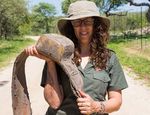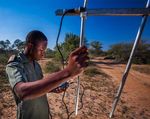ALIVE Studying Kruger's elephants for 20 years!
←
→
Page content transcription
If your browser does not render page correctly, please read the page content below
SPECIES ID ‒ MAMMALS | RESEARCH PROJECT
African elephant (Loxodonta Africana).
Photo © Christin Winter
ELEPHANTS
ALIVE
Studying Kruger’s
elephants for 20 years!
by Harriet Nimmo
46 KRUGER
KRUGER
MAGAZINE
MAGAZINE
| Issue| 4Issue
– Winter 2018 2018
4 – WinterSPECIES ID ‒ MAMMALS | RESEARCH PROJECT
Black rhinoceros (Diceros
bicornis), commonly referred
to as ‘black rhino’, have been
relentlessly persecuted since the 19th
century and there are only about
5 000 animals remaining today.
Ruthless poaching across Africa, and
presently in South Africa, threatens
the survival of the species on a global
scale. South African National Parks
“The biggest challenge is ‘trying to provide advice on both
(SANParks) has established a Black
Rhino Guardian Programme in theto best manage expanding populations in fenced reserves
how
Kruger National Park, whichwithin South Africa, while simultaneously educating people on
hosts the
largest population of black rhino in alarming pan-African decline facing elephants’.”
the
the country. This multidisciplinary
programme draws support from
Scientific Services, Ranger Services,
K
Air Services and Veterinary
Wildlife Services to enable the best
management and protection possible
for the species. ruger is home to For 20 years, Elephants Alive,
one of southern the Hoedspruit-based NGO, has
Af rica’s largest been studying the elephants of
f ree-ranging the Greater Kruger to ensure their
elephant survival, and to promote harmony
populations. with humans.
With the fences We have developed an
down, elephants identification database of nearly 2
can move throughout the Great 000 elephants by photographing
Limpopo Transf rontier Park. This and drawing their unique features.
includes Kruger National Park We identify individual elephants
and the Associated Private Nature by their sex, ear patterns (tears,
Reserves (APNR) bordering the notches, holes) and the shape of
park (Timbavati, Klaserie, Umbabat, their tusks. Monitoring individual
Balule and Thornybush) in South elephants for 20 years has enabled
Af rica, Gonarezhou National Park us to understand their social
in Zimbabwe and Parque Nacional bonds, their breeding behaviour,
do Limpopo in Mozambique. and their movements over time.
Black rhinoceros. Photo © Estiaan Houy
KRUGER MAGAZINE | Issue 4 – Winter 2018 47SPECIES ID ‒ MAMMALS | RESEARCH PROJECT
“From zero ivory poaching
incidents three years ago,
Kruger has lost close to 100
elephants to poaching over the
past 18 months, mainly in the
north of the Park.”
social interactions, record their
vocal communications, and
try to understand the genetic
relatedness between bulls
by DNA-testing their dung.
These last two activities are
undertaken in collaboration
with Cambridge University.
Our research is helping us to
understand the importance
of the oldest bulls in elephant
society, sadly deemed by trophy
hunters to be ‘beyond their
prime’ and by poachers as their
most lucrative targets because
of their large tusks. We have
watched these long-lived old
males teach, lead and discipline
Collared elephant ‘Classic’, about 45 years old.
Photo © Mike Kendrick
We have also radio-collared
and named 80 elephants
since 1998, so we can follow
their movements in greater
detail throughout the Great
Limpopo Transfrontier Park.
We have focused our attention
on monitoring and naming
mature bulls because much less
is known about male elephants.
Males can also be more at risk
of being involved in human-
elephant conflicts such as crop
raiding – and of course big bulls
are top of poachers’ hit lists.
We map the movements of EA Researcher Ronny Makukule tracking elephants.
these collared bulls and their Photo © Neil Aldridge
48 KRUGER
KRUGER
MAGAZINE
MAGAZINE
| Issue| 4Issue
– Winter 2018 2018
4 – WinterSPECIES ID ‒ MAMMALS | RESEARCH PROJECT
the younger bulls. Elephants
revere their elders, relying on
their wisdom to teach them
their ways – something we
humans sadly seem to have lost.
Our elephant ID studies are the
longest and most consistent
for all of southern Africa. This long-
term research is providing fundamental
information for elephant management
and protection, informing SANParks,
conservation bodies and private
landowners on seasonal movements,
the sustainability of trophy hunting in
some private reserves, and impact on
vegetation. Worryingly, it is now also
used to identify poaching hotspots. Michelle re-collaring ‘Classic’.
“Our elephant ID studies are the
longest and most consistent for all
of southern Africa. This long-term
research is providing fundamental
information for elephant
management and protection.”
Africa has already lost a
third of its savannah elephant
population during the past
seven years. There has been a Tranquilised elephant during re-collaring.
Photos © Mike Kendrick
65% decline in forest elephants
over a ten-year period. The
staggering decimation of
elephant herds in Mozambique that, while it is not yet out of on how elephants move relative
and Tanzania (53% and a 60% hand in South Africa, poaching to their resources in order to
decline respectively over a is a real threat. The reality hit better manage their impact on
five-year period) has left many home when one of Elephants the vegetation. Elephants were
concerned that elephant Alive’s collared bulls, ‘Charlie’, culled from 1967 to 1994 in an
poaching in South Africa was poached at the end of 2017, attempt to keep the population
will increase. From zero ivory just a few weeks after having densities around 6 000. Today,
poaching incidents three years had his collar fitted in Parque the population is closer to
ago, Kruger has lost close to 100 Nacional do Limpopo. 20 000, so understanding their
elephants to poaching over the Our research has also movements is critical to any
past 18 months, mainly in the provided very valuable decisions required across the
north of the Park. information to SANParks, which Great Limpopo Transfrontier
It is Elephant Alive’s belief requires detailed information Park as a collective whole.
KRUGER MAGAZINE | Issue 4 – Winter 2018 49SPECIES ID ‒ MAMMALS | RESEARCH PROJECT
“As well as identifying and
studying the movements of
elephants, Elephants Alive
also works hard to minimise
human-elephant conflict.”
As well as identifying and
studying the movements of
elephants, Elephants Alive
also works hard to minimise
human-elephant conflict.
One of the biggest issues is
elephants damaging large
trees – particularly in the private
reserves bordering Kruger,
where there are more artificial
waterholes, which attract more
elephants in times of drought
or during the dry season when
they are primarily browsers.
Some private landowners are
calling for elephants to be shot
to reduce tree damage. Elephants Alive outreach work at schools.
Elephants bypassing a tree with beehives.
Photo © Robin Cook
“It is known that elephants
Beekeepers hanging beehives in a tree.
do not like bees.”
Photo © Mike Kendrick
50 KRUGER
KRUGER
MAGAZINE
MAGAZINE
| Issue| 4Issue
– Winter 2018 2018
4 – WinterSPECIES
SPECIES ‒ MAMMALS
ID ID ‒ MAMMALS
| RESEARCH
| RESEARCH
PROJECT
PROJECT
Elephants Alive
Elephants Alive’s team is led by
Dr Michelle Henley, co-founder, CEO
and principal researcher. Named as
one of “the ten most inspiring women
in South Africa” by Culture Trip in
2017, Michelle is one of conservation’s
unsung heroes. When asked what
Elephants Alive’s biggest challenge
is, Michelle explains that the biggest
challenge is “trying to provide
advice on both how to best manage
expanding populations in fenced
reserves within South Africa, while
simultaneously educating people
on the alarming pan-African decline
facing elephants”.
Dr Michelle Henley, CEO, with an elephant collar.
Photo © Mike Kendrick
Since 2004, more than 3 000 marula trees whose trunks were Black Mamba anti-poaching
individual trees have been protected with wire netting and patrols, improving community
monitored to understand 54% of trees with no protection. liaison efforts and providing
elephant impact, including 62 The beehives provide a win-win inspirational role models for
trees with southern ground solution – protecting iconic young learners. Elephants
hornbills and 226 trees with trees, generating honey for sale Alive also runs collaborative
raptor/vulture nesting sites. Half and reducing human-elephant programmes with Wild Shots
of these trees have had wire net conflict. Photography Outreach,
wrapped around their trunks It is Elephant Alive’s belief targeting young learners in
to prevent bark-stripping by that, to ensure the long-term communities where there is
elephants. The three iconic tree preservation of these free- human-elephant conflict.
species that we focus on are ranging elephants, it is critical With expanding human
marula, knobthorn and false to empower, inform and involve populations putting ever
marula. The results from this impoverished local communities. more pressure on Af rica’s
study highlight this cost-effect We run education programmes reserves and National Parks,
measure to protect large trees. with rural communities and and increasing threats f rom
It is known that elephants government schools. We work poaching, Elephants Alive’s work
do not like bees, and beehive closely with the all-female is increasingly crucial.
fences have been successfully
used in East Africa to protect
farmers’ crops. Elephants
Alive has pioneered innovative
research, using beehives
Contact us
suspended in a number of Elephants Alive
iconic marula trees over a info2u@elephantsalive.org
two-year study period. Our
research showed that only 2%
of study trees with beehives Visit our website on: www.elephantsalive.org
experienced any elephant Follow us on Facebook
damage, compared to 28% of
KRUGER MAGAZINE | Issue 4 – Winter 2018 51You can also read



























































